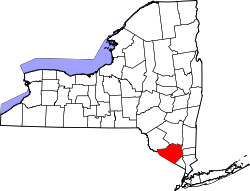West Point, New York | |
|---|---|
 Aerial view from southwest includes the Hudson River, Highland Falls (on right), Cold Spring (on left) across the river in Putnam County | |
 Location in New York and Orange County | |
Location in New York Location in the United States | |
| Coordinates: 41°23′42″N73°57′18″W / 41.39500°N 73.95500°W | |
| Country | United States |
| State | New York |
| County | Orange |
| Town | Highlands |
| Area | |
• Total | 19.34 sq mi (50.08 km2) |
| • Land | 18.44 sq mi (47.75 km2) |
| • Water | 0.90 sq mi (2.33 km2) |
| Population (2020) | |
• Total | 7,341 |
| • Density | 398.2/sq mi (153.75/km2) |
| Time zone | UTC−5 (Eastern (EST)) |
| • Summer (DST) | UTC−4 (EDT) |
| ZIP Codes | 10996–10997 |
| Area code | 845 |
| FIPS code | 36-80747 [2] |
West Point is the oldest continuously occupied military post in the United States. Located on the Hudson River in New York, General George Washington stationed his headquarters in West Point in the summer and fall of 1779 during the American Revolutionary War, and later called it "the most important Post in America" in 1781 following the war's end. West Point was also the site of General Benedict Arnold's failed attempt at treason during the Revolutionary War.
Contents
- History
- American Revolutionary War
- Post-war
- Geography and climate
- Demographics
- West Point Mint
- Notable people
- Transportation
- Train station gallery
- Education
- See also
- Explanatory notes
- References
- External links
West Point was first occupied by the United States Armed Forces in January 1778 by Brigadier General Samuel Holden Parsons. Since then, West Point has been occupied by the United States Army. It comprises 25.1 sq mi (65 km2) land and water, including the campus of the United States Military Academy, which is commonly referred to as "West Point".
West Point is a census-designated place (CDP) located in the town of Highlands in Orange County, located on the western bank of the Hudson River. The population was 7,341 at the 2020 census. It is part of the Kiryas Joel–Poughkeepsie–Newburgh metropolitan area as well as the larger New York–Newark, NY–NJ–CT–PA Combined Statistical Area.










